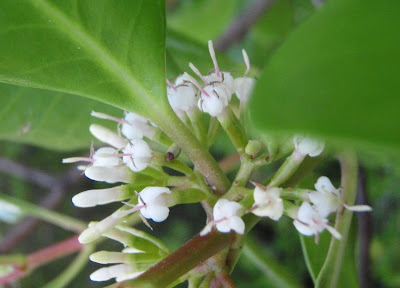Fifty fifth Discovery Posting
Just the past May day (1st May) till 3rd of May, I was at Tanjung Sutera Resort at Sedili, Johor for a short holiday with friends. It was a place where you could really see NO city landscapes, the horizon and a view of South China sea. Here's a photo of the rocky shores you can find there. This was taken from the resort (picture below).
 Here's a closer view of the rocky shores (picture below).
Here's a closer view of the rocky shores (picture below). Besides a rocky shore, you can also find mangroves, coastal forests and a sandy beach there. Great getaway for anyone who wants to take a break and those who seek to avoid those very commercialised resorts.
Besides a rocky shore, you can also find mangroves, coastal forests and a sandy beach there. Great getaway for anyone who wants to take a break and those who seek to avoid those very commercialised resorts.Anyway, for this post, I'll focus on some plants which can be found at the mangroves of Sedili.
So for first 'discovery', we have the flowers of the Teruntum (this common name is for both Lumnitzera racemosa and L. littora, the beautiful flowers you find in the picture below is from Lumnitzera littora).
 Discovery Note:
Discovery Note:1. Timber harvested from the Teruntum is often used for furniture.
2. You can find this plant usually at the back mangroves (areas which are flooded during high spring tides or very high high tides).
Second 'discovery' is the Chengam, Scyphiphora hydrophyllacea (picture below shows the flowers).
 The Chengam's leaves and fruit (picture below)
The Chengam's leaves and fruit (picture below) Discovery Note:
Discovery Note:1. This is a shrub that grows both in the mangroves and along sandy beaches.
2. This plant has waxy leaves which reduce water loss through transpiration (A common feature for some plants found in the mangroves, along sandy beaches and coastal forests)
3. This plant has durable wood which is useful for making small, hardy objects.
4. Indigenous people are known to use the warm extracts from the leaves to treat stomach aches.
Third 'discovery' is a butterfly which I think which looks like a Common Tiger at first sight, but after checking, I feel this looks more like a Black Veined Tiger (Danaus melanippus hegesippu), a butterfly I've never seen before (picture below)!
 Discovery Note:
Discovery Note:1. This butterfly can be usually found near mangrove or coastal areas.
2. This species is often confused with the Common Tiger. But if you look closely, the broad submarginal black band in the Black Veined Tiger is broader and this distinguishes it from the Common Tiger. And unlike the Common Tiger, this species has no orange forms. See the difference with a photo of the Common Tiger that I've taken from the NIE Butterfly Garden.
Fourth 'discovery' is the Bakau minyak, Rhizophora apiculata, you can see its flowers in the picture below.
 A way to tell this species apart from the other Rhizophora species is the red stipule it has and it having dark green leaves (picture below).
A way to tell this species apart from the other Rhizophora species is the red stipule it has and it having dark green leaves (picture below).  And of course, the tiny black spots you can find on the underside of its leaves (picture below).
And of course, the tiny black spots you can find on the underside of its leaves (picture below). Discovery Note:
Discovery Note:1. This mangrove tree is a source of timber and charcoal.
Fifth 'discovery' is the Buta-buta, Excoecaria agallocha or more commonly known as 'blind your eyes'. You can see that this tree has white sap and this sap can cause blisters on the skin and even blindness if it comes in contact with the eyes of anyone (picture below)
 A way to identify this tree is that it has multicoloured leaves where the young leaves are pink while the old leaves turn red. The picture below shows a old leaf.
A way to identify this tree is that it has multicoloured leaves where the young leaves are pink while the old leaves turn red. The picture below shows a old leaf. A 'bigger' picture of the Buta-buta (picture below).
A 'bigger' picture of the Buta-buta (picture below). All in all, it was a great getaway for everyone who was there => Thanks to LK for organising this trip and my room mates (RY and SJ) for a fun-filled trip.
All in all, it was a great getaway for everyone who was there => Thanks to LK for organising this trip and my room mates (RY and SJ) for a fun-filled trip.Extra:
a) Check out more photos from the trip from SJ's NatureScouter Blog.
b) And for discoverers who wish to find out more about the resort, click here for their website.
1 comment:
hanks for the info. Very useful to me.
Post a Comment